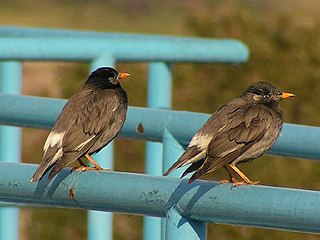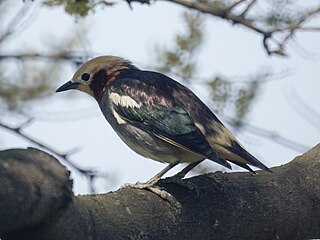
A passerine is any bird of the order Passeriformes which includes more than half of all bird species. Sometimes known as perching birds, passerines generally have an anisodactyl arrangement of their toes, which facilitates perching.

The bulbuls are members of a family, Pycnonotidae, of medium-sized passerine songbirds, which also includes greenbuls, brownbuls, leafloves, and bristlebills. The family is distributed across most of Africa and into the Middle East, tropical Asia to Indonesia, and north as far as Japan. A few insular species occur on the tropical islands of the Indian Ocean. There are 166 species in 32 genera. While different species are found in a wide range of habitats, the African species are predominantly found in rainforest, whereas Asian bulbuls are predominantly found in more open areas.

The mimids are the New World family of passerine birds, Mimidae, that includes thrashers, mockingbirds, tremblers, and the New World catbirds. As their name suggests, these birds are notable for their vocalization, especially some species' remarkable ability to mimic a wide variety of birds and other sounds heard outdoors. They are commonly referred to as mimic thrushes but are not, in fact, thrushes.

Starlings are small to medium-sized passerine birds in the family Sturnidae, common name of Sturnid. The Sturnidae are named for the genus Sturnus, which in turn comes from the Latin word for starling, sturnus. The family contains 128 species which are divided into 36 genera. Many Asian species, particularly the larger ones, are called mynas, and many African species are known as glossy starlings because of their iridescent plumage. Starlings are native to Europe, Asia, and Africa, as well as northern Australia and the islands of the tropical Pacific. Several European and Asian species have been introduced to these areas, as well as North America, Hawaii, and New Zealand, where they generally compete for habitats with native birds and are considered to be invasive species. The starling species familiar to most people in Europe and North America is the common starling, and throughout much of Asia and the Pacific, the common myna is indeed common.

The mynas are a group of birds in the starling family (Sturnidae). This is a group of passerine birds which are native to Iran and Southern Asia, especially Afghanistan, India, Pakistan, Bangladesh, Nepal and Sri Lanka. Several species have been introduced to areas like North America, Australia, South Africa, Fiji and New Zealand, especially the common myna, which is often regarded as an invasive species. It is often known as "Selarang" and "Teck Meng" in Malay and Chinese respectively in Singapore, due to their high population there.

The oxpeckers are two species of bird which make up the genus Buphagus, and family Buphagidae. The oxpeckers were formerly usually treated as a subfamily, Buphaginae, within the starling family, Sturnidae, but molecular phylogenetic studies have consistently shown that they form a separate lineage that is basal to the sister clades containing the Sturnidae and the Mimidae. Oxpeckers are endemic to the savanna of Sub-Saharan Africa.

Sylviidae is a family of passerine birds that includes the typical warblers and a number of babblers formerly placed within the Old World babbler family. They are found in Eurasia and Africa.

The family Cisticolidae is a group of about 160 warblers, small passerine birds found mainly in warmer southern regions of the Old World. They were formerly included within the Old World warbler family Sylviidae.

The white-eyes are a family, Zosteropidae, of small passerine birds native to tropical, subtropical and temperate Sub-Saharan Africa, southern and eastern Asia, and Australasia. White-eyes inhabit most tropical islands in the Indian Ocean, the western Pacific Ocean, and the Gulf of Guinea. Discounting some widespread members of the genus Zosterops, most species are endemic to single islands or archipelagos. The silvereye, Zosterops lateralis, naturally colonised New Zealand, where it is known as the "wax-eye" or tauhou ("stranger"), from 1855. The silvereye has also been introduced to the Society Islands in French Polynesia, while the Japanese white-eye has been introduced to Hawaii.

The yellow-billed oxpecker is a passerine bird in the family Buphagidae. It was previously placed in the starling and myna family, Sturnidae.

Acridotheres is a genus of starlings, the "typical" mynas, which are tropical members of the family Sturnidae.

Lamprotornis is a large genus of glossy-starlings all of which occur in Africa south of the Sahara. They have glossy blue or green upper parts, which is due to hollow melanin granules arranged in a single layer near the feather barbule's surface. This unique arrangement led to some glossy starlings formerly placed in the genus Spreo being transferred to Lamprotornis, since they shared this feature.

The white-cheeked starling or grey starling is a passerine bird of the starling family. It is native to eastern Asia where it is a common and well-known bird in much of its range.

Stenostiridae, or the fairy flycatchers, are a family of small passerine birds proposed as a result of recent discoveries in molecular systematics. They are also referred to as stenostirid warblers.

The chestnut-cheeked starling is a species of starling in the family Sturnidae. It breeds in Japan and the Russian islands of Sakhalin and Kuriles; it winters in Taiwan, the Philippines and northern Borneo.

The Daurian starling, or purple-backed starling, is a species of bird in the starling family found in the eastern Palearctic from eastern Mongolia and southeastern Russia to North Korea and central China.

Sylvioidea is a superfamily of passerine birds, one of at least three major clades within the Passerida along with the Muscicapoidea and Passeroidea. It contains about 1300 species including the Old World warblers, Old World babblers, swallows, larks and bulbuls. Members of the clade are found worldwide, but fewer species are present in the Americas.

Sturnia is a genus of Asian birds in the starling family Sturnidae. It is sometimes merged with Sturnus.

Staphida is a genus of passerine birds in the white-eye family Zosteropidae.

Agropsar is a genus of Asian birds in the family Sturnidae. It is sometimes merged with Sturnus or Sturnia



















